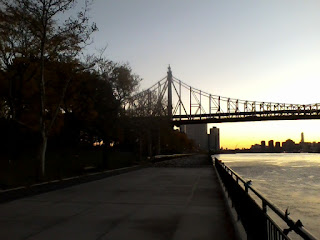Unless you do all of your cycling on unpaved surfaces, you are bound to see road signs during your rides.
We don't notice, or think about, most of them because we see them so often. Others simply don't apply to us.
But some are really strange. For example, there was the one that said, "Graffiti is a crime camera enforced". Was that sign trying to tell us that graffiti is camera-enforced? Or that graffiti is a camera-enforced crime?
Then there was the one that warned us, "Use of cameras prohibited and strictly enforced". Now, perhaps I'm not the smartest person in the world, but I can't, for the life of me, understand how something can be prohibited and strictly enforced.
Some signs leave you wondering who is their intended audience and what, exactly, they are trying to tell said audience. I saw an example today not far from my apartment.
About a kilometer from my place, next to the East River (which isn't actually a river), there's a Con Ed power plant. It's located on Vernon Boulevard, which rims the river, just south of the bridge to Roosevelt Island.
(Interestingly, there's a Moishe's storage facility across Vernon Boulevard that used to be a factory that made Loft candy. Now I wonder how much I--and members of my family ate! Well, I guess I shouldn't worry yet: Nobody's glowing in the dark!)
Anyway, a bike lane now runs along the western edge of Vernon. As it happens, the lane directly crosses the path of the Con Ed plant's driveway, through which trucks enter and exit.
The traffic lane that borders the bike lane handles southbound traffic. A driver headed in that direction would not be able to read the sign, except perhaps in a rearview mirror. The northbound traffic is so far to the right that most drivers probably wouldn't see the sign. Even if they did, it probably wouldn't matter, as neither the driveway nor the bike lane enter, or intersect with, the northbound traffic lane.
The bike lane is sub-divided into a northbound and southbound lane. As with the auto traffic, southbound riders wouldn't see this sign. Even if they glanced back to look at it, the sign would be useless to them, as they would have already crossed the driveway.
So, I have to wonder: For whom was this sign intended? (Or, in market-research speak: Who is the intended audience?) And what was the sign's creator trying to tell the intended audience?
You have to wonder what some people are thinking when they make and post signs.
We don't notice, or think about, most of them because we see them so often. Others simply don't apply to us.
But some are really strange. For example, there was the one that said, "Graffiti is a crime camera enforced". Was that sign trying to tell us that graffiti is camera-enforced? Or that graffiti is a camera-enforced crime?
Then there was the one that warned us, "Use of cameras prohibited and strictly enforced". Now, perhaps I'm not the smartest person in the world, but I can't, for the life of me, understand how something can be prohibited and strictly enforced.
Some signs leave you wondering who is their intended audience and what, exactly, they are trying to tell said audience. I saw an example today not far from my apartment.
About a kilometer from my place, next to the East River (which isn't actually a river), there's a Con Ed power plant. It's located on Vernon Boulevard, which rims the river, just south of the bridge to Roosevelt Island.
(Interestingly, there's a Moishe's storage facility across Vernon Boulevard that used to be a factory that made Loft candy. Now I wonder how much I--and members of my family ate! Well, I guess I shouldn't worry yet: Nobody's glowing in the dark!)
Anyway, a bike lane now runs along the western edge of Vernon. As it happens, the lane directly crosses the path of the Con Ed plant's driveway, through which trucks enter and exit.
The traffic lane that borders the bike lane handles southbound traffic. A driver headed in that direction would not be able to read the sign, except perhaps in a rearview mirror. The northbound traffic is so far to the right that most drivers probably wouldn't see the sign. Even if they did, it probably wouldn't matter, as neither the driveway nor the bike lane enter, or intersect with, the northbound traffic lane.
The bike lane is sub-divided into a northbound and southbound lane. As with the auto traffic, southbound riders wouldn't see this sign. Even if they glanced back to look at it, the sign would be useless to them, as they would have already crossed the driveway.
So, I have to wonder: For whom was this sign intended? (Or, in market-research speak: Who is the intended audience?) And what was the sign's creator trying to tell the intended audience?
You have to wonder what some people are thinking when they make and post signs.







